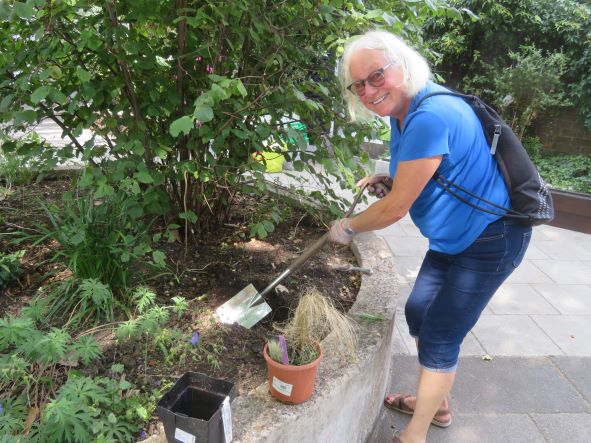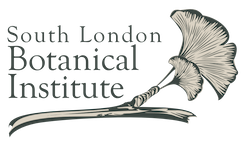The SLBI is keen to work with community groups of all kinds, with the aim of sharing knowledge about plants and inspiring action on climate change. Here are some of our projects.
Pavement Plants for People
In 2022 this project was created in partnership with the South London Botanical Institute (SLBI), Station to Station Business Improvement District (S2S), Lambeth Council and Streetworks.
At the start of 2024 local group Open Orchard Project took on the maintenance; they will be adding more plants and building a citizen gardening team to nurture them. To get involved go to SE27 Citizen Gardeners on the Open Orchard website.
‘Pavement Plants for People’ is a community planting project funded by the Mayor of London’s Grow Back Greener Fund. The aim of the project was to transform grey pavement spaces into greener, cleaner environments that improve the physical and mental well-being of local residents, improve air quality, and create important wildlife habitat that increases biodiversity and helps to combat climate change within the local area.
Included within the project are 14 new planted oil drums along Norwood High Street and Norwood Works, 6 planted raised beds and rain gardens and 9 newly created depaved areas along the pavements of Norwood Road.
Organised and led by the SLBI Education team, all planting was done by local residents, school children and community groups, helping people to learn gardening skills, environmental knowledge and the importance of plants as well as having the chance to come together and meet new people in their local community.
The following educational trail was created to support the project and encourage greater participation with these new green areas.
Oil drums along Rothschild Street and Knight’s Hill
These containers are made out of recycled 205L oil drums and painted with Mylands Blue paint obtained from Mylands, the last remaining paint manufacturers in London. Mylands is based just around the corner in Norwood Works, the largest industrial estate in Lambeth. They were planted up by students from Dunraven Sixth Form College.
The oil drums have gravel at their base to improve drainage and to add weight, peat-free organic compost and are planted with edible herbs, ivy, Salvias and Erigeron daisies. These plants were chosen as they are pollinator friendly and tolerant to pollution and drought.
Opposite the oil drums on Rothschild Street you will find West Norwood Bzz Garage, a community garden situated around West Norwood Bus Garage. Bee-friendly habitats have been created and there is an orchard, a wildflower meadow and edible crops growing.

Wooden planters located outside 17 Knight’s Hill, 457 Norwood Road, the entrance to Parade Mews at 196 Norwood Road, and 158 Norwood Road.
Some of the plants chosen are:
- Red Robin (Photinia x fraseri) is an evergreen shrub with glossy leaves that are bright red when young, turning dark green as they mature. It has creamy white flowers in the springtime, followed by red berries. They like a sunny position and well-drained soil, so are suitable for growing in the drier summers we are experiencing now.
- Winter Daphne (Daphne odora) is an evergreen shrub grown for its clusters of fragrant, nectar-rich, pink flowers in late winter and early spring. It is a compact plant, perfect for containers, providing colour in winter and food for our local pollinators in the cold months.
- Sage (Salvia officinalis) is a bushy shrub with aromatic, soft, grey-green leaves and pale blue flowers which the bees love in early summer. The name Salvia comes from the Latin for ‘I heal’ and sage was originally used as a healing plant by the Greeks and the Romans. Now it is mainly used in cooking or as a tea for coughs and sore throats.
- Mahonias are very popular with bumblebees and provide a valuable food source when they flower in spring. This variety is called ‘Smaragd’: it has dark green leaves that turn reddish-purple in winter and bright yellow flowers followed by blue-black fruit in the summer/autumn. The flowers are strongly scented and often compared to Lily of the Valley.
These planters were built by Father Nature (158 and 457 Norwood Road), a landscape gardening and horticulture enterprise based in South London, and Mark Bilton (17 Knight’s Hill and Parade Mews).
Hoopla Gardens, opposite 264 Norwood Road
Originally created by Edible Bus Stop in 2012, the design of the circular beds was inspired by the game of ‘hoopla’ where rings are thrown to be caught on wooden pegs (the remaining bollards on the site). The area is now used to grow a mixture of edible and wildlife friendly plants and is a haven for pollinators and local school children eating lunch.
As part of the ‘Pavement Plants for People’ project, the SLBI and local residents cleared and tidied the beds and added spring flowering bulbs, pollinator-friendly plants and three new trees to the gardens:
- a Crab Apple (Malus sylvestris): a tree associated with love and marriage; its colourful little apples can be used to make tasty jelly. In spring, the fragrant blossom is loved by bees and other insects.
- a Snowy Mespilus (Amerlanchier lamarckii): a pretty, deciduous tree that has bronze-tinged young leaves in spring, that turn orange and red in autumn. The white, star-shaped flowers are rich in pollen and nectar and later in the year produce delicious red to dark purple/black berries that the birds love to eat.
- a Loquat (Eriobotrya japonica): an evergreen tree grown for its orange fruits in summer and for its tough and leathery leaves which can be used to make tea.

Depaved beds outside 288 – 296 Norwood Road
The SLBI planted these two beds with children from Julian’s Primary School in West Norwood.
All of the trees with silver-white bark planted along here are Silver Birches (Betula pendula). They are native to the UK and have light green, triangular-shaped leaves that fade to yellow in the autumn. Their flowers are ‘catkins’ that hang in groups from April to May; the male flowers are longer and more yellow than the shorter, greener female ones.
In the beds we planted Hebes, Salvias, Persicaria (Bistort), Nepeta (Catmint) and Erigeron daisies for the pollinators. They are drought tolerant and will add colour in the summer months.
Depaved bed on the corner of York Hill and Norwood Road
The SLBI planted this bed with families from Natural Childhood Community Group. It was created to have a woodland feel, as it is situated under two trees. The trees are a Cherry tree (closest to Norwood Road) and a Hazel tree, both of which are pollinator friendly.
The depaved beds are not very deep (only about 30-35cm in depth) so we chose plants that would not grow too big or need deep soil. We chose the Japanese anemones (Anemone x hybrida), Hart’s Tongue ferns (Asplenium scolpendrium), Bugle (Ajuga reptans), Japanese spurge (Pachysandra terminalis) and hardy geraniums to grow amongst the Mahonia and Hebes. All of these plants are hardy (they tolerate very cold temperatures) and are capable of tolerating the windy conditions on this corner.
Depaved bed outside 280 Norwood Road
The SLBI planted this bed with children from Dunraven Secondary School.
The tree here is a Maple (Acer campestre), a pretty native tree that is pollution tolerant and habitat friendly to caterpillars and other insects. It has shiny, green leaves with 5 lobes that turn golden yellow in the autumn and large winged fruits, tinged pink, that are spread by the wind.
We planted other drought and pollution tolerant plants here – Hebes, Persicaria (Bistort), Salvias, Geraniums, Nepeta (Catmint), Epimediums, Pachysandra and Erigeron daisies. They will also provide a food source to pollinators and colour in the summer.
Depaved beds outside 252 – 264 Norwood Road
The SLBI planted these beds with the children of Elmgreen Secondary School.
The tree here is a False or Black Locust tree (Robinia pseudoacacia), originally from North America. It is considered a ‘weed’ or invasive species in some areas but in the UK it is becoming a more common street tree.
The planting here is similar to the other depaved beds along this section of road – Hebes, Persicaria (Bistort), Salvias, Geraniums, Nepeta (Catmint), Epimediums, Pachysandra and Erigeron daisies. They are drought and pollution-tolerant and will also provide food for pollinators and colour in the summer.

Depaved beds outside 196 Norwood Road
The SLBI planted these beds with children from The Norwood School.
The trees here are London Plane trees (Platanus x hispanica): they grow to be large, graceful trees and line many of the streets around London. They are extremely pollution tolerant – their distinctive, flaking bark helps them to get rid of pollutants. They have distinctive winter seeds that look like pompoms dangling from the branches.
The planting here is similar to the other depaved beds along this section of road – Hebes, Persicaria (Bistort), Salvias, Geraniums, Nepeta (Catmint), Epimediums, Pachysandra and Erigeron daisies. They are drought and pollution-tolerant and will also provide food for pollinators and colour in the summer.
